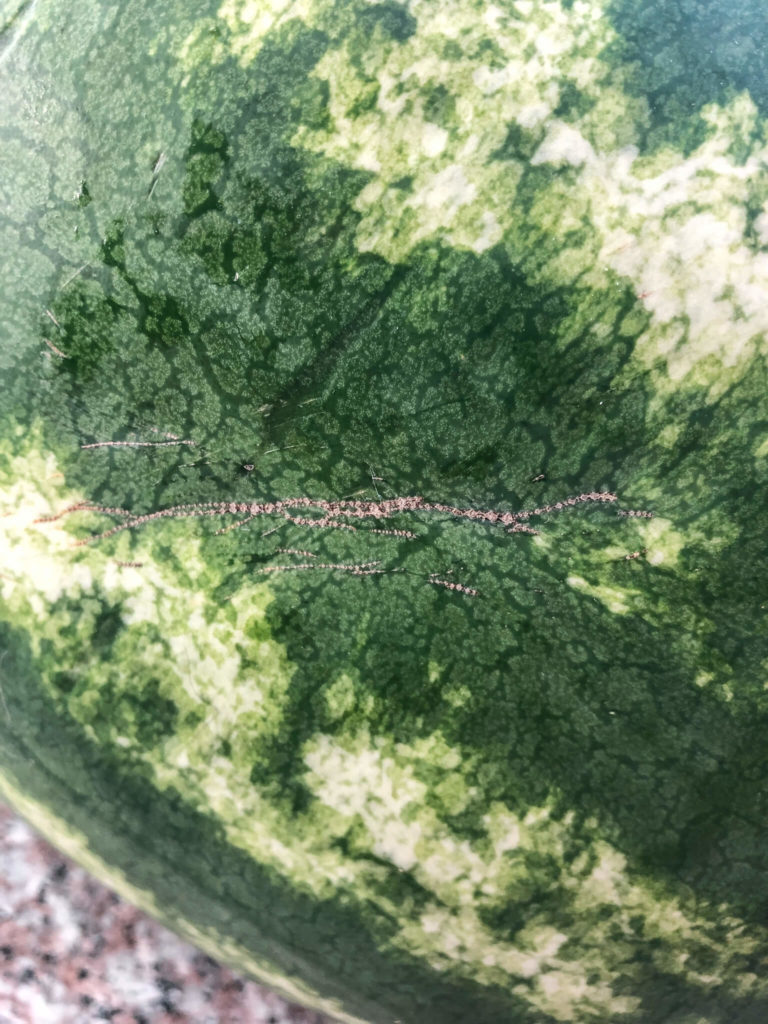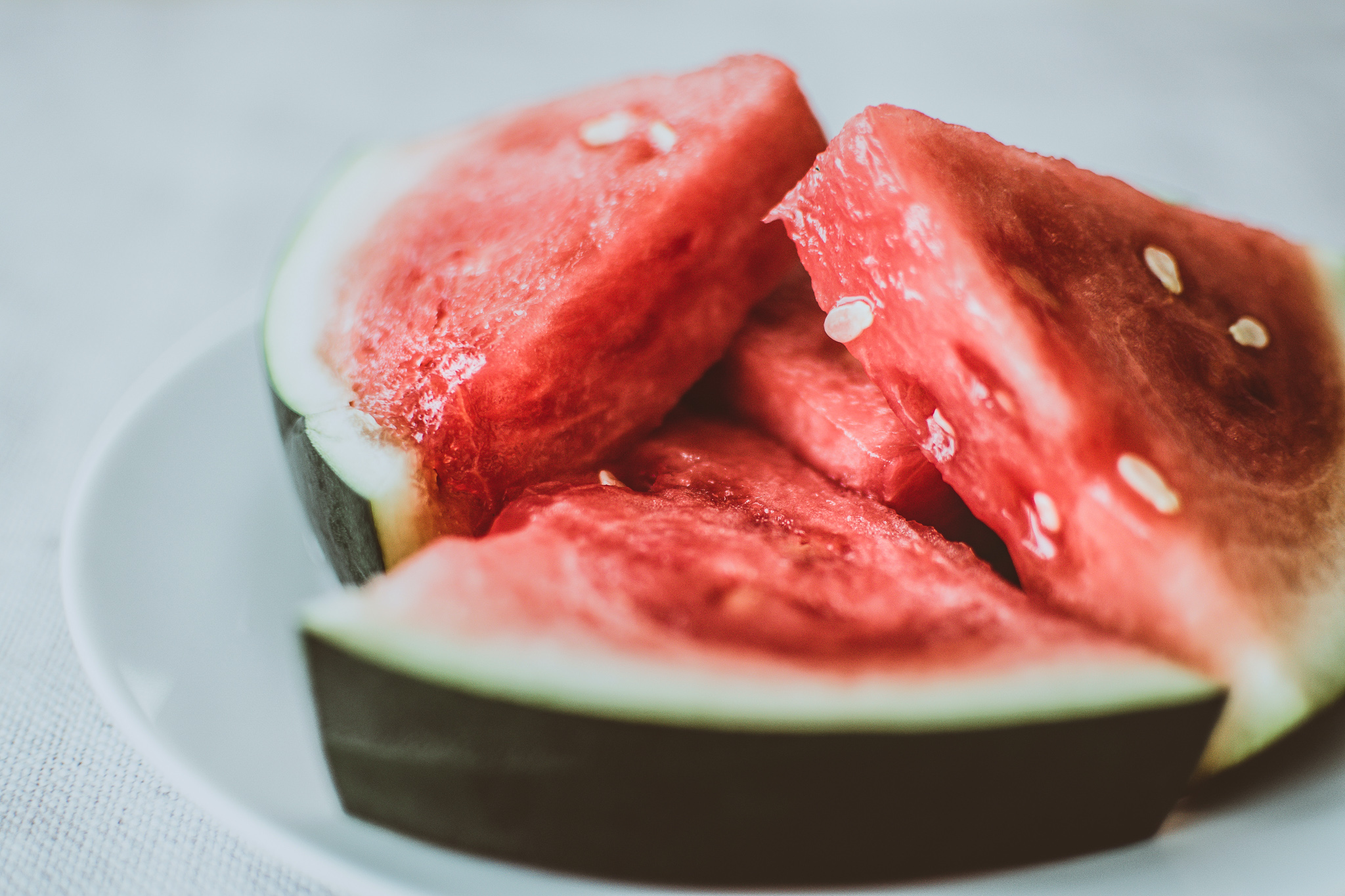It’s watermelon season! I adore watermelon, but have a historical habit of wasting most of it when I purchase one. I would buy a giant one and then it would go bad before I finished it. I’ve since improved my habits, partly in thanks to friends who sent me their best ways to use it (special shout out to the one who recommended homemade watermelon margaritas). I think part of the reason I’ve started to finish my melons is because I’m pretty good at picking them out.
This hasn’t always been the case. I used to be that person, standing at the watermelon bin, slapping and knocking on melons, acting like I knew what sound I was looking for, but was actually clueless and just hoping for the best. I’m so glad I’m no longer that person (not that there’s anything wrong with you, if you are – just know there are better ways). What are those better ways?
Using watermlon growing methods and science to your advantage
Knowing how melons are grown helps to understand what physical signs point toward a watermelon being ripe, juicy, and delicious. Look for these characteristics to more likely pick a good melon the next time you’re at the grocery store.
A yellow patch on the watermelon

A good indicator that a melon was given ample time in the field to soak up the sun’s rays and get ripe is a yellow patch on one side. This spot is where the melon was in contact with the ground and the more yellow it is, the longer it was on the ground, in the field, getting all nice and ripe.
Watermelon are non-climacteric, meaning they will not continue to ripen or get sweeter once they have been harvested. This means you want a melon that was given the full amount of time in the field that it needed to get ripe. Depending on the variety, watermelon take 70 – 90 days to reach maturity and be ready for harvest.
Nice and heavy
A bunch of articles online say to pick a watermelon that “seems heavier than it should be.” No offense to those writers, but that seems zero percent helpful to me. And I don’t think I’m the only one who feels that way. My advice? Ignore the part about what it should weigh, and just make sure you’re getting a heavy one. Weigh various melons of the same size and see if one weighs more than the others – that’s probably more effective than guessing what it should weigh.
Watermelons are, surprise surprise, meant to be full of water. Water is heavy. A heavy melon indicates that it is watery/juicy and not dry and mealy. Some sources on the internet that aren’t super scientific say that as watermelons age off the vine, they lose some of their water content. If these sources are correct, that means that heavier watermelons could also be fresher.
Uniform shape
There are many varieties of watermelon grown and they have many different appearances and characteristics: seeded, seedless, mini, dark skinned, perfectly round, long and oval, etc. Because of the that, you don’t want to hold to a rule like “round is better” or something like that – it’s going to vary by variety.
You do want it to be completely uniform in its shape though. If it’s a long, oval variety, you want a very defined oval, not one that is narrower on one side than the other, for instance. Being uniform indicates that the melon has finished it’s growing period and filled out in all the right places.
Black dotted lines

Speaking of non-scientific sources…if you Google “selecting a good watermelon,” a vast majority of the results are going to include something about choosing one that has webbing and scratches that have tiny black/brown dots in the lines. They say that the dots are sugar leaking out of the melon and that that melon will be very sweet. There’s also notes about the webbing being because of more pollination.
Most of the pages with that info all use nearly identical verbiage, which makes me feel like they copy it from each other, and I couldn’t find any scientific, university, or extension type documents that support it (not saying they don’t exist, I just didn’t find them).
If you’ve been around my blog long, you probably know that I like scientific and data driven information. So, it seems suspect that I can’t find that info from “reputable sources.”
However, I do have good luck with choosing those kind of ugly watermelons, with dotted lines and webbing. So don’t feel like you need to choose the prettiest, most perfect watermelon in the bin. Like mamas say, “It’s what’s on the inside that counts.”
Hollow heart
Not related to picking it out, but if you get home and cut open your melon, only to find that the inside is hollow: don’t stress. It doesn’t guarantee that it won’t be good and there is nothing bad for you about it. Hollow heart happens when a watermelon hasn’t been pollinated as well as it needed to be.
Watermelons are pollinated by bees and, according to the University of Florida, need 1,000 grains of pollen deposited on their flowers to be adequately pollinated. Not receiving the correct amount of pollination will result in a fruit that doesn’t necessarily form fully.
Note the grower
Many watermelon have stickers that indicate who grew it, or what farm it came from. When you buy one, note that sticker. If you like the watermelon, it’s likely you will enjoy more from that farm because they will have used the same harvest guidelines across the board. In the same way, if you continue to get bad melons from the same grower, it might be time to try someone else.
I wish you the very best of luck
Sometimes, it feels like it does come down to luck. Even following all of the “rules”, you can still find yourself with a watermelon that doesn’t meet your expectations. However, using these guidelines increases your chances of getting a good one.
Do you have any tried and true methods you use to pick good melons? Let me know in the comments.

Yes I always put the melon up the my ear and knock on it. I just assume people admire my technique. I would never let a watermelon go to waste unless I picked a really bad one. I’ll eat it within a few days.
What’s the tone of sound you’re looking for? I know so many people rely on sound – I just don’t know what I’m looking for and can’t rely on it. I’m sure people are full of admiration!
Great article on watermelon, Jordyn! Just in time for the Hermiston kind which, I don’t know, are always good to me! I like that they are grown in Oregon. I usually won’t buy a watermelon until I know it’s a Hermiston. Peoria Road Farm Market is where I buy watermelon. I like to support local farms and Oregon grown fruits and vegetables. I go with the weight and the yellow spot, the bigger the better. I also look for the webbing (never knew what to call it before reading your article) and the little spots with the blob! How scientific is that? My sister in law told me once that was a “bee sting”. I trust the bees! So, Hermiston, I can’t wait for your first crop!
Hermiston melons are good! It’s wonderful that Oregon grows so many wonderful fruits and vegetables for us to enjoy 🙂 It sounds like you have a solid method down – trusting the bees is a good way to go!